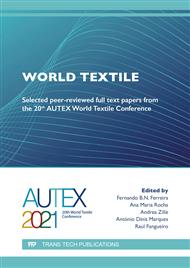[1]
Iida, I. (2005) Ergonomia: projeto e produção. 2a. Editado por E. Blucher. São Paulo.
Google Scholar
[2]
Hoffman, M. E. (2003) «Bases Biológicas do Envelhecimento», Revista Idade Ativa. Campinas, SP.
Google Scholar
[3]
Shilling, C. (2005) The body in culture, technology and society. London: Sage Publications Ltda.
Google Scholar
[4]
Marques, N. R., Hallal, C. Z. e Gonçalves, M. (2010) «Características biomecânicas, ergonômicas e clínicas da postura sentada: uma revisão», Fisioterapia e Pesquisa, 17(3), p.270–276.
DOI: 10.1590/s1809-29502010000300015
Google Scholar
[5]
Meinander, H. and Varheenmaa, M. (2002) Clothing and textiles for disabled and elderly people, VTT TIEDOTTEITA – RESEARCH NOTES 2143 Clothing. Finland: JULKAISIJA – UTGIVARE –PUBLISHER. Disponível em: http://www.vtt.fi/inf/pdf/tiedotteet/2002/T2143.pdf.
Google Scholar
[6]
Silveira, I. (2006). Aplicação da ergonomia no projeto do vestuário. Moda palavra: reflexões em moda, Florianópolis, v. 4, pp.12-19.
Google Scholar
[7]
PASCHOARELLI, L. C. (2013). Conhecimento científico e a prática profissional da ergonomia: a contribuição da ergonomia física no design de produtos. In: BARBOSA, A.C.L.S.; RANGEL, M. M.; RAPOSO, M. (Org.). Ergonomia design usabilidade interação. Juiz de Fora: Mamm UFJF.pp.77-93.
DOI: 10.17771/pucrio.acad.31359
Google Scholar
[8]
Grube, C.; Vergara, L. G. L. (2019). Ergonomia Aplicada ao Projeto do Produto: O Ponto de Vista de Designers do Vestuário. GEPROS. Gestão da Produção, Operações e Sistemas, v. 14, nº 2, p.149 – 170.
DOI: 10.15675/gepros.v14i2.2211
Google Scholar
[9]
Skepper, N.; Straker, L.; Pollock, C. (2000). A case study of the use of ergonomics information in a heavy engineering design process. International Journal of Industrial Ergonomics, v. 26, n. 3, pp.425-435.
DOI: 10.1016/s0169-8141(00)00017-2
Google Scholar
[10]
Maffei, S. T. A. (2010) O produto de moda para o portador de deficiência física: análise de desconforto. Universidade Estadual Paulista (UNESP). Disponível em: http://hdl.handle.net/11449/89699.
Google Scholar
[11]
Caldas, A. L.(2017). Adequação do Vestuário para Idosas Dependentes de Cuidados, Considerando a sua Modificação Anatômica. Universidade do Minho-Portugal. Tese de Doutoramento. Disponível em: https://core.ac.uk/download/pdf/154274187.pdf.
Google Scholar
[12]
Küppers, H. (1992) Fundamentos de la teoría de los colores. México: Gustavo Gili.
Google Scholar
[13]
Pinheiro, M. C. e Silva, F. M. da (2010) Comunicação Visual e Design Inclusivo, Cor, legibilidade e visão envelhecida. In. Design ergonômico – estudos e aplicações. ( Orgs.) SILVA, J. C. P. da, PASCHOARELLI, L. C., SILVA, F. M. 1a ed. Bauru: FAAC - Universidade Estadual Paulista.
Google Scholar
[14]
Rosa, L. da (2011).Vestuário Industrializado: Uso da Ergonomia nas Fases de Gerência de Produto, Criação, Modelagem e Prototipagem. Pontifícia Universidade Católica do RJ. Tese de Doutoramento. Disponível em: https://www.maxwell.vrac.puc-rio.br/18873/18873_1.PDF.
DOI: 10.17771/pucrio.acad.18873
Google Scholar
[15]
Hoff, T. (2016) Comunicação publicitária: dos regimes de visibilidade do corpo diferente às biossociabilidades do consumo. In: Corpos discussivos: dos regimes de visibilidade às biossociabilidades do consumo. Tânia Hoff (Org.). Recife: Editora UEPE.
DOI: 10.18568/cmc.v18i52.2490
Google Scholar
[16]
Meyer, G. C. (2008). Reflexões sobre a caracterização da pesquisa científica e da prática profissional no design, em Anais do 8o Congresso Brasileiro de Pesquisa e Desenvolvimento em Design. Rio de Janeiro: Associação de Ensino e Pesquisa de Nível Superior de Design do Brasil (AEND|Brasil). Disponível em: https://www.researchgate.net/publication/286048833_Reflexoes_sobre_a_caracterizacao_da_pesquisa_e_da_pratica_profissional_em_design.
DOI: 10.5151/designpro-ped-01062
Google Scholar



